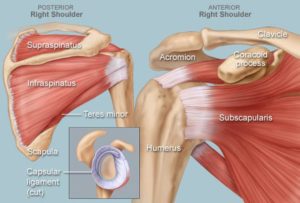The shoulder is one of the most complicated joints in the body. It is a ball and socket joint like the hip, but because the shoulder has much more motion than the hip it also has less stability – making it more susceptible to injury. In order to reduce the risk of shoulder injury it’s important to have good upper back posture as well as strong postural muscles. These systems hold your shoulder in the socket correctly while doing day to day activities or sports.
Shoulder Bones and Joints
The bones that make up the shoulder joint consist of the humerus, scapula, and clavicle. There are 3 joints in the total shoulder complex, which together allow the shoulder to move through its full range of motion. These joints are the glenohumeral joint, the acromioclavicular joint, and the sternoclavicular joint. The scapulothoracic joint, where the scapula (shoulder blade) connects to the back and rib cage, also needs to be considered during analysis of shoulder function. While not a ‘true joint’, this interface does also assist in allowing shoulder mobility. When all of these structures function in proper alignment with the correct timing, risk of shoulder injury is reduced. Unfortunately, most people are guilty of utilizing improper shoulder mechanics while sitting at their desk at work, doing chores around the house, or participating in exercise or their favorite sport. This can lead to tissue irritation or injury.

Common Injuries of the Shoulder Complex
Because there are multiple structures surrounding the shoulder joint in a small space, it can be difficult to determine the tissue that is irritated when shoulder pain occurs. Listed below are some common injuries that can occur at the shoulder, a description of which tissues are impacted, and common symptoms for each impairment.
Shoulder Impingement
Shoulder impingement (which basically means “pinching”) can occur when the space between the end of the clavicle and the top of the humerus is too small, causing the rotator cuff tendons and potentially also one of the biceps tendons to become irritated. This small space is typically impinged because of poor mechanics and/or failure to utilize the correct stabilizing muscles to hold the shoulder in optimal alignment.
- Common Symptoms:
- Pain with reaching overhead
- Pain reaching across your body with movements such as grabbing your seat belt
- Feelings of weakness in the shoulder
- Pain primarily in the front of the shoulder

Labrum Tear
The labrum is a ring of cartilage that lines the inside of the shoulder joint. It can be injured in a traumatic injury such as a fall onto the shoulder or an outstretched arm, or from repetitive microtrauma. Microtrauma is often the result of doing an activity many times with improper form. Because the labrum is cartilage, with poor blood supply, the likelihood of healing a tear is low. However, many people note a reduction in symptoms even without repairing a tear if they are able to improve their mechanics and increase strength and endurance of their postural muscles.
- Common Symptoms
- Pain at night
- A ‘dull ache’ deep in the shoulder
- Feelings of shoulder instability
- ‘Popping’ or ‘clicking’ on movement – sometimes with and sometimes without pain

Rotator Cuff Tear
Rotator cuff tears can be due to a traumatic injury, but are more commonly due to repetitive microtrauma. A rotator cuff tear can occur over time if a shoulder impingement goes untreated. The muscles of the rotator cuff include: supraspinatus, infraspinatus, teres minor, and subscapularis. The most important action of the rotator cuff is to ‘depress’ or hold the glenohumeral joint in its socket properly. Sitting a lot during daily activities, or doing exercises with your shoulders rounded too far forward often create a situation during which the shoulder joint fails to be aligned in its socket properly. Over time this will irritate the rotator cuff and potentially lead to tearing. There are different degrees to which the rotator cuff may be torn. If there is a small tear it may successfully be treated conservatively with physical therapy. If the tear is larger or if there is a complete tear then function is typically more significantly impacted and surgical intervention is sometimes necessary.
- Common Symptoms
- Sharp pain with any shoulder movement (often worst when moving the shoulder out to the side)
- Weakness – particularly in overhead motion and/or outward rotation of the arm
- With a full tear there may be minimal pain but significant weakness – sometimes noted when the arm is unable to be lowered from an elevated position in a controlled fashion

Although there are other multiple other shoulder issues, these are some of the most common injuries that occur in the shoulder complex. The therapists at Symmetry Physical Therapy are very familiar with treating these issues, as well as all types of shoulder injuries. If you are having shoulder pain and are unsure if you are a good candidate for Physical Therapy, contact us for an assessment. If you are not currently experiencing pain, but feel as if your motion is limited or that you could benefit from some work on your posture, we can help with that too!
In the meantime, if you’d like to learn more about shoulder problems, check out these links to the APTA’s Move Forward website, that contain extended descriptions of Shoulder Impingement, Labral Tears, & Rotator Cuff Tears.

